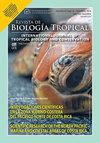墨西哥改良景观中灰拟鹦鹉(鹦鹉形:鹦鹉科)的觅食生态学
IF 0.6
4区 生物学
Q4 BIOLOGY
引用次数: 0
摘要
引言:热带森林的季节性酚类变化导致食物资源可利用性的变化。动物在这些环境中使用觅食策略来跟踪食物供应。橙额长尾鹦鹉(Eupsittula canicularis)主要栖息在墨西哥太平洋至哥斯达黎加西北部的热带干燥森林中,尽管人们对其饮食和觅食策略知之甚少。目的:评估墨西哥瓦哈卡海岸改良景观中橙额长尾小鹦鹉食物资源丰度、饮食和觅食行为的空间变异性。方法:在旱季(2019年2月至6月)建立30条(200×6m)的酚样带,以测量原始落叶林、半落叶林和次生林的食物资源可用性。橙额长尾鹦鹉的饮食是通过重点觅食观察确定的,饮食生态位广度和资源选择被考虑来确定喂养策略。结果:橙额长尾鹦鹉以13种植物的果实(42.3%)、种子(29.3%)和花朵(28.4%)为食,在原始森林中觅食频率较高,具有广阔的食物生态位宽度。橙额长尾鹦鹉根据每个栖息地的食物资源可用性来选择资源并调整觅食策略。结论:研究结果强调了在改良景观中保持完整森林结构的必要性,以确保橙额长尾鹦鹉在繁殖季节的食物资源可用性。本文章由计算机程序翻译,如有差异,请以英文原文为准。
Foraging ecology of the bird Eupsittula canicularis (Psittaciformes: Psittacidae) in a modified Mexican landscape
Introduction: Seasonal phenological variations in tropical forests cause changes in food resource availability. Animals use foraging strategies to follow the food supply in these settings. The Orange-fronted Parakeet (Eupsittula canicularis) mainly inhabits the tropical dry forest of the Mexican Pacific to Northwest Costa Rica, although little is known about its diet and foraging strategies. Objective: To assess spatial variability in food resource abundance, diet, and foraging behavior of the Orange-fronted Parakeet in a modified landscape in Oaxaca Coast, Mexico. Methods: 30 phenology transects (200 × 6 m) were established during the dry season (February-June 2019) to measure food resource availability in primary deciduous, semi-deciduous, and secondary forests. The Orange-fronted Parakeets diet was determined by focal foraging observations, and dietary niche breadth and resource selection were considered to determine feeding strategies. Results: Orange-fronted Parakeets fed on fruits (42.3 %), seeds (29.3 %), and flowers (28.4 %) of 13 plant species and presented a broad dietary niche breadth with a higher frequency of foraging in primary forest. The Orange-fronted Parakeets select resources and adapt their foraging strategies based on food resource availability in each habitat. Conclusions: The study findings highlights the need to maintain the complete forest structure in a modified landscape to ensure food resources availability for Orange-fronted Parakeets during the breeding season.
求助全文
通过发布文献求助,成功后即可免费获取论文全文。
去求助
来源期刊

Revista De Biologia Tropical
生物-生物学
CiteScore
1.80
自引率
0.00%
发文量
23
审稿时长
4-8 weeks
期刊介绍:
The Revista de Biología Tropical / International Journal of Tropical Biology and Conservation is a mainstream scientific journal published since 1953 and covered by Web of Science; Science Citation Index; Current Contents; Google Scholar; Scopus, SciELO and nearly 50 additional indices.
A double blind system guarantees you a fair evaluation, and our world class editorial and scientific boards provides a first decision in three working days. The journal is Full Open Access and is widely read where your article can have the highest real impact.
Since its beginning in 1953, the Revista follows these principles: objective and independent evaluation of all manuscripts; transparency in all processes; ethical use of procedures, data, specimens and subjects; fair treatment of all parties; and absolute predominance of scientific rigor over any other aspect.
 求助内容:
求助内容: 应助结果提醒方式:
应助结果提醒方式:


